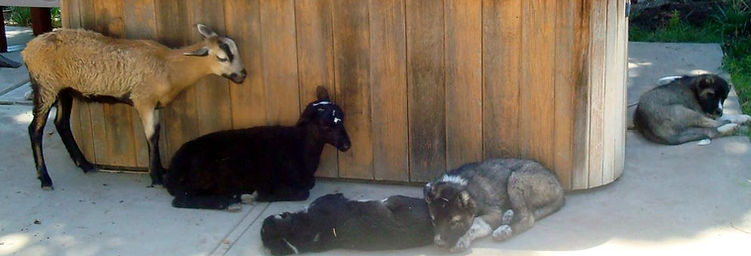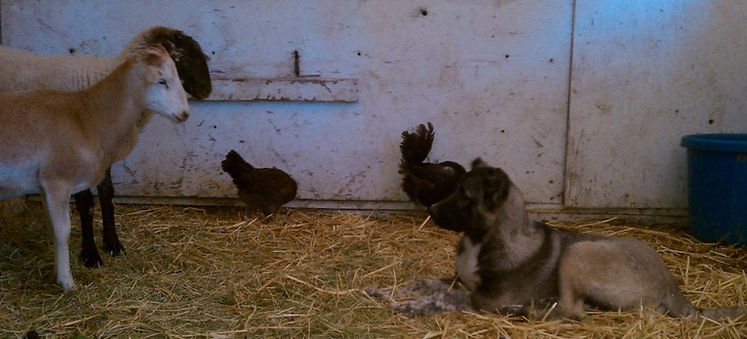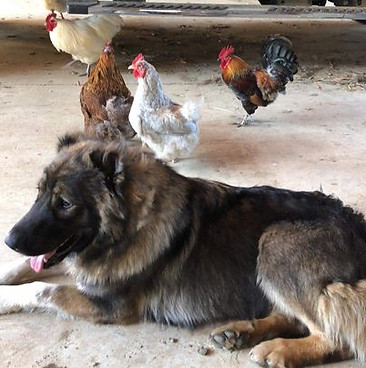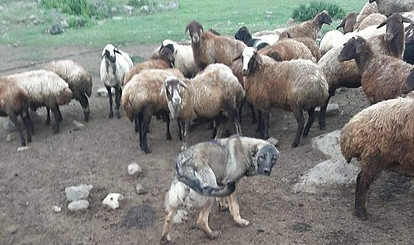
INTRO TO TRAINING
Raising an LGD
in summary
Raising an Armenian Gampr as a livestock guardian can be either easy or adventurous, but their essential nature is to do well and guard their charges. Learning is partly automatic, as the instinct is within our dogs, but it depends on a developed partnership between the gampr and its owner.
It takes time to become a mature, level-headed LGD, but there is no definite answer on how long that should take. Each dog, owner, and farm are individualistic with much variability, so the only way to know that the dog is ready is for the owner to observe the dog, understand its instincts and decide if the dog has learned self-control. Some dogs are trustworthy from very early on, and others are later to mature. Sometimes things can go wrong and set you back, but while it may be upsetting, know that no one person or dog is perfect, and a moment of bad behavior does not mean the dog is not LGD material.
Some pups will adjust more quickly than others. A few do not appear to learn anything about caring for livestock until they are older, but we like to see the correct instinct emerge before that. The owners can effectively nurture this instinct, and the more positive, relevant response from you about your pup's behavior, the easier it will be for your pup to learn.
One big key piece for training your gampr is to predict bad behavior before it happens, and that is done by redirecting the pup prior to any reaction. The more closely you monitor your gampr, you'll know what to expect from him. The more time you spend with him, the more you will understand him, his reactions, and any weaknesses. Use those predictions to create a safe and positive learning experience for him instead of leaving him in a situation where he is likely to fail. All activity with new animals, especially very young ones, must be brief and supervised to prevent problems.
Second, LGD pups, particularly gamprs, respond best to a positive affirmation of appropriate behavior and slight correction when needed. If the amount of correction outweighs the positive feedback, your pup will likely resist further training and be ‘set up for failure.’
And finally, the time of day does make a difference. Puppies, and even adults, are more active around sunrise and sunset. At these times, keeping untrustworthy young pups or dogs in neutral areas is recommended to work off energy safely to prevent any playing with livestock. It is a perfect time to let them play with other dogs and children or romp around the non livestock area of the farm. After the pup tires, they will be ready to eat and rest. Take that opportunity to take the dog into the livestock area for a slow walk or maybe even a nap.

This pup could be quickly moved out of the goat area, prior to an incident, if the owner suspected he was getting restless or wanted to play.

A sleepy pup has been put in with lambs and chickens for a late-morning nap and "training".
Intros
the basics
Some might say it isn't necessary for an LGDs to know any obedience training but if your dog knows the basics, such as sit, stay, wait, leave it, come here, it is indeed very handy for redirection or recalling your pup during livestock training. Read more about how to start your gampr with basic obedience training.
After your pup has a full belly, take advantage of their mid morning calm time to foster positive interactions with your livestock. Do not let aggressive livestock alarm your pup with unwarranted punishment as to keep the visit positive and comfortable.
During a meeting with stock, if a pup gets excited, it may grab at the livestock and excitement may turn to chewing which can ‘reward’ the pup with a tasty treat. This can result in injury to all involved, mistrust of livestock toward the pup, and mutual dislike between the gampr and the livestock. To prevent this, anticipate the puppy's intentions and redirect him prior to those reactions.

5 months old gampr pup is letting her maternal instinct show, by allowing a baby goat to search for milk – and the gampr is gentle, kind, and nurturing
Poultry, Specifically
fluffy feathers
Chickens can be more difficult for a young pup to adjust to than hooved animals. Gamprs also hunt for small prey in the mountains of Armenia, and their prey drive is intact- but they will be able to discriminate among their own animals if taught correctly.
The fluffy feathers and squawking of chickens is a temptation for pups. To set them up for positive feedback, keep them controlled when near chickens. If you observe that your pup does not get ‘frisky’ or overly interested with the chickens, you may let the pup off leash during mellow moments, but always be ready to intervene.
In Armenia, young gamprs are made to live with chickens at all times, and they are constantly monitored. In the USA, we might not be able to monitor young dogs all day long, so restrict their access to poultry to times when they can be fully supervised.

Young import, Koton, with a few members of her flock

A large goose and a duck, perfect for starting pups, running off a young pup
It is recommended to begin with adult poultry, and it may take several times over many months before your Gampr is poultry safe. Start by walking your dog on a leash through the poultry area and continue doing so several times a day. Over time you'll notice the dog is seemingly bored and unexcitable on the poultry walkthroughs, and they will no longer be new to her, Once the pup is showing calm, trustworthy behavior during the walks, he will be ready to try visiting off-leash.
Start the off-leash visit during a sleepy time of day with a full belly, your leash close by, and tasty snacks in your pocket. Act quickly to redirect with a recall and give lots of treats and happy praise for listening and behaving calmly.
Body Language
cues
Dogs, in general, are very good at communicating, so when training an LGD, it's essential to be watchful of body cues they may be giving to prevent an incident or understand a reaction. If at any time you see unwanted body language from your gampr, it would be best to take a step back in his training.


Bari, at around the age of 6 months, was still living in Artsakh when these photos were taken. She displays excellent and appropriate body language with sheep. Notice that her tail and general body is lowered, easing through the sheep so as not to disturb them. Below she is affectionate with her stock, happily allowing them to inspect her.

Body language of dogs is actually very similar to human body language. To understand dominance play, picture two people at the gym, shoving each other around in a playful way, chests out, standing tall. Dogs do this also and can take it very seriously. So if you see this type of play among your pack of dogs, its ok, but it's not ok when it extends to the livestock. This can lead to games that become more rough, and result in injured livestock which can lead to your dog becoming more of a problem than an actual protector.
The Border Collie below is an example of the exact posturing and body language that you never want to see your gampr direct toward livestock. Notice the eyes are glaring and focused, lips are drawn back, the body is aimed like an arrow pointed directly toward it's prey and the muscles along the neck and back are tensed.
